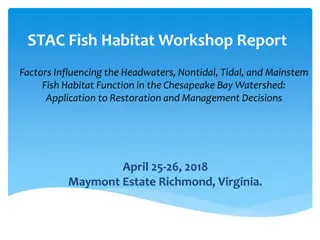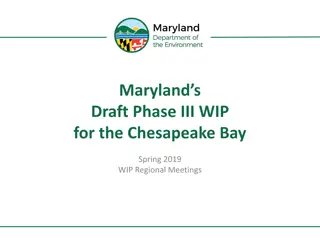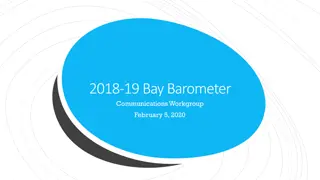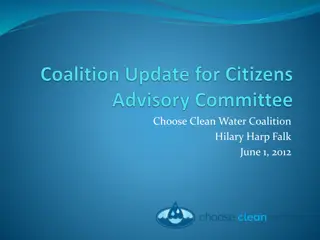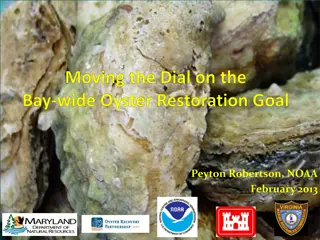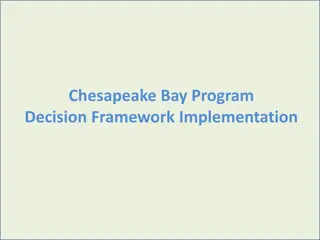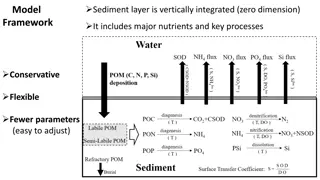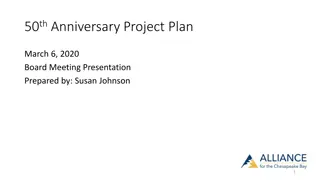Chesapeake Bay Nontidal Monitoring Network Report
This report highlights the measurement of nitrogen, phosphorus, and suspended sediment loads at the Chesapeake Bay Nontidal Network stations, emphasizing trends and analysis conducted by various professionals. It discusses the response to restoration activities and land use changes, aiming to inform water quality progress, document improvements, and enhance models for better management practices. The report underscores the importance of monitoring data in tracking water quality changes and supporting ecosystem management initiatives.
Download Presentation

Please find below an Image/Link to download the presentation.
The content on the website is provided AS IS for your information and personal use only. It may not be sold, licensed, or shared on other websites without obtaining consent from the author.If you encounter any issues during the download, it is possible that the publisher has removed the file from their server.
You are allowed to download the files provided on this website for personal or commercial use, subject to the condition that they are used lawfully. All files are the property of their respective owners.
The content on the website is provided AS IS for your information and personal use only. It may not be sold, licensed, or shared on other websites without obtaining consent from the author.
E N D
Presentation Transcript
Nitrogen, Phosphorus, and Suspended- Sediment Loads and Trends Measured at the Chesapeake Bay Nontidal Network Stations: PA Emphasis Mike Langland USGS Citizens Advisory Council June 21, 2016
Acknowledgements Load and Trend Analysis Jeff Chanat Gavin Yang Mike Langland Joel Blomquist Ken Hyer Bob Hirsch Mike Mallonee Doug Moyer Many Others!! USGS Nontidal Web Page (http://cbrim.er.usgs.gov/) Cassandra Ladino Scott Phillips Water-Quality Monitoring Partners U.S. Environmental Protection Agency NY State Dept. of Env. Conservation Susquehanna River Basin Comm. DE Dept. Natural Resources and Env. Control VA Dept. of Env. Quality U.S. Geological Survey (All Bay States) PA Dept. of Env. Protection DC Dept. of the Environment MD Dept. of Natural Resources WV Dept. of Env. Protection WV Dept. of Ag.
Chesapeake Bay Nontidal Monitoring Network (1) How are nitrogen, phosphorus, and suspended- sediment loads responding to restoration activities and changing land use across the Bay watershed -- by site and subwatershed? (2) What are the trends in nitrogen, phosphorus, and suspended-sediment loads being delivered to the Chesapeake Bay from the nontidal portions of the watershed?
Importance of Monitoring Data Explain water-quality progress Document water quality improvements Response to management practices Inform management Mid Point Assessment (2017) 2-yr Progress milestones by CBP Watershed Implementation Plans (WIP) Progress toward Chesapeake Bay TMDL s Enhance models with monitoring data to explain change CBP WSM and Estuarine models USGS SPARROW
USGS Nontidal Web Page http://cbrim.er.usgs.gov/
Chesapeake Bay Nontidal Monitoring Network Purpose Collect water-quality samples using consistent methodology Collect water-quality samples across the full range of hydrologic conditions Specific Objectives Increase spatial resolution across land uses, rock types, drainage area Add sites to help with model calibration, WIP sites, political boundaries 5 years for loads, 10 years for trends Monitoring Stations 117 monitoring stations 30 with records > 30 yrs 81 with records > 10 yrs 6 with records 5-10 yrs 30 (green on map) with records < 5 years 34 sites PA, 40 in Susquehanna RB Drainage areas range from 1 to 27,100 mi2 mi2 Monitoring Stations 117 monitoring stations 30 with records > 30 yrs 81 with records > 10 yrs 6 with records 5-10 yrs 30 (green on map) with records < 5 years 34 sites PA, 40 in Susquehanna RB Drainage areas range from 1 to 27,100
WHY LOAD and TREND ESTIMATION? Loads (concentration times streamflow) TMDL Reflects actual changes in nutrient and sediment inputs with changing stream flow Compare sites using load per acre Trends in load Changes due to landuse, input sources, and BMPs Analyze ancillary data to further refine Use USGS statistical package to estimate loads and trends from monitoring data (WRTDS, Hirsch and others, 2010, Moyer and others, 2012) Remove affects of climatic variability; effects of human- induced change can be more easily identified
Susquehanna River At Marietta, PA, 1987-2014 Load and Trend Example: Susquehanna River Total Nitrogen 33% reduction Long-term trends 30 sites 13% reduction Short-term trends 87 sites TMDL Allocation Goal
Nontidal Network -Results Loads Pounds per acre Trends Directional change Total mass change
Total Nitrogen per Acre Loads Bay watershed Range: 1.19 to 33.4 lbs/ac Average: 7.33 lbs/ac PA results: 3.3-33.4 lbs per acre Avg 11.5 lbs per acre Highest in southern areas
Total Nitrogen per Acre Loads and Trends: 2005-2014 Chesapeake Watershed Improving Trends: 54% Degrading Trends: 27% No Trend: 19% PA: Majority improving Improving: 14 Degrading: 3 No change: 1
Changes in Nitrogen per Acre Loads: 2005-2014 Susquehanna Watershed
Changes in Nitrogen per Acre Loads: 2005-2014 Improvements - WWTP upgrades - Point source reductions - Agricultural practices - Land reversion - Less N in rainfall Download figure: http://cbrim.er.usgs.gov/maps.html
PHOSPHORUS - Point sources (WW) - Non point sources - Natural sources 16
Total Phosphorus per Acre Loads and Trends: 2005-2014 Loads per acre: Higher in PA Lower part of basin Bay Watershed trends: Improving Trends : 68% Degrading Trends : 20% No Trend : 12% PA trends: Majority improving Improving: 13 Degrading: 3 No change: 1
Changes in Phosphorus per Acre Loads: 2005-2014 Susquehanna Watershed
Changes in Phosphorus per Acre Loads: 2005-2014 Improvements - Point source upgrades - Agricultural practices - Land conversion - Construction management actions Download figure: http://cbrim.er.usgs.gov/maps.html
Suspended Sediment per Acre Loads and Trends: 2005-2014 Watershed: loads per acre Range 18 to 2,206 lbs/ac Average load of 482 lbs/ac PA similar Watershed Trends Improving: 50% Degrading: 30% No Trend : 20% PA: mixed results Improving: 8 Degrading: 3 No change: 6
Chesapeake Bay Nontidal Monitoring Network Loads to the Bay (Question #2) What are the trends in nitrogen, phosphorus, and suspended-sediment loads being delivered to the bay from the nontidal portions of the watershed? To answer this question, we look to the loads delivered from the nine River Input Monitoring stations.
Changes in Total Nitrogen Delivered to the Bay Estuary from the 9 RIM Stations Less Improvement in nitrogen, phosphorus, and sediment at the RIM sites vs. upstream sites. WHY?
*Although the Susquehanna and Potomac Rivers carry the largest loads, all RIM stations have an influence on their respective estuary.
Summary Watershed Trends 1. What Works Upgrades to Industrial/WWTPs Reductions in air emissions Some agricultural practices 2. Challenges Response times Continued development and intensified agriculture Ag will be asked for more reductions 3. Future Monitoring Target restoration efforts at high loading locations Target urban storm water Improve ancillary data (explain trends From UMCES, USGS, EPA (2014)
Summary - PA Highlights High loads per acre in some areas Nitrogen: Lower SE portion of basin Phosphorus: Lower Eastern portion Improving trends Total Nitrogen and Phosphorus Mixed Results for Sediment Other Challenges: continued development, intensified ag, lag times










